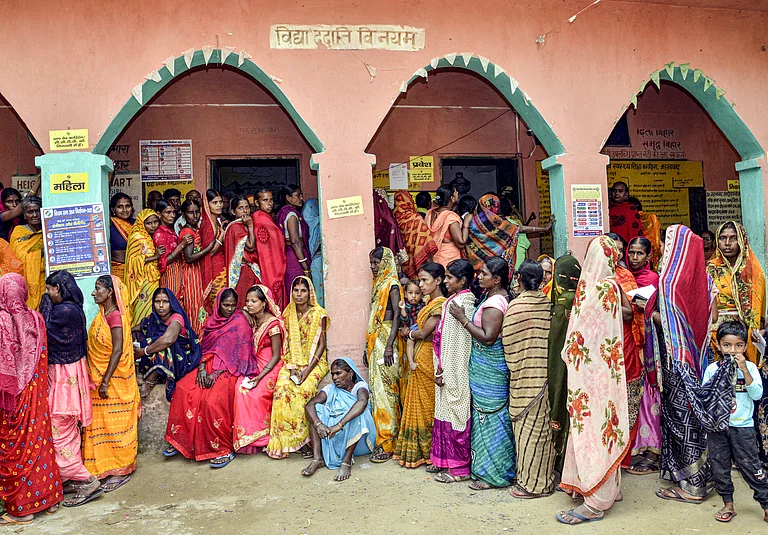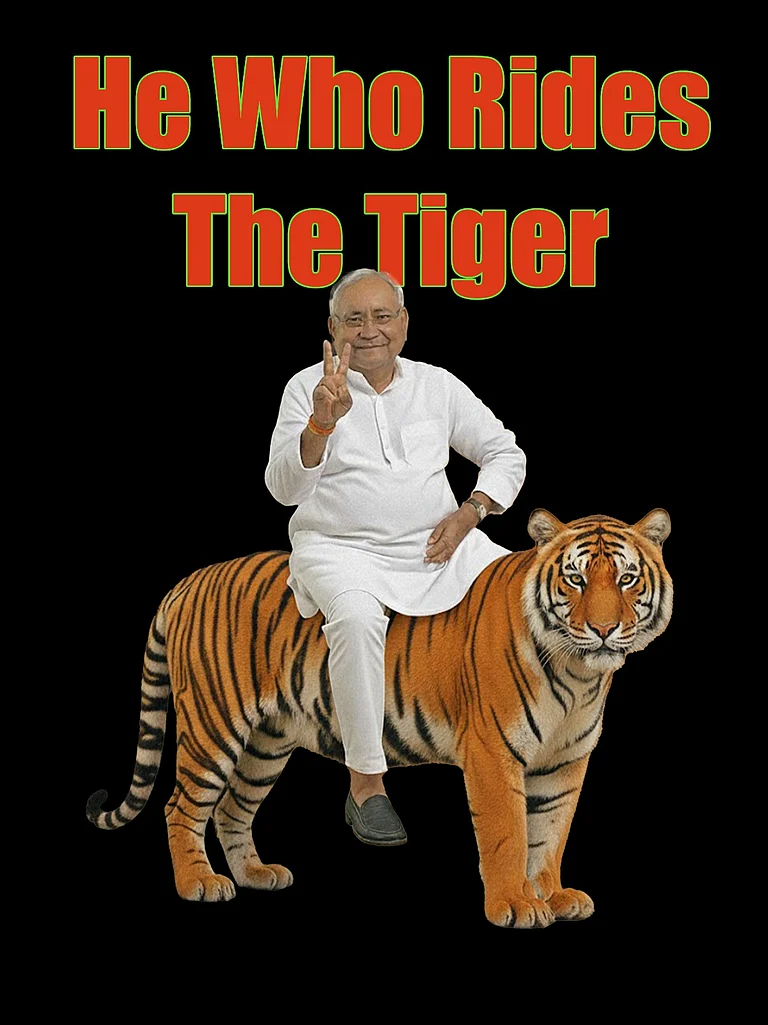In the Bihar Legislative Assembly the National Democratic Alliance (NDA) secured a massive number of 202 seats of the total of 243.
This time, the new challenger, election strategist Prashant Kishor, cut a sorry figure with his Jan Suraaj drawing a big zero.
The NDA government’s undisguised bribery of women voters with Rs 10,000 to each woman member of a family under a quickly-cooked up Mukhyamantri Mahila Rojar Yojana
Scrutinising the Sweep In Bihar Election
Nitish Kumar won because he appeared more credible, while Tejashwi Yadav’s promises seemed too far-fetched
To learn to lose is an art, but it gets quite complex when winning becomes a crafty science. This came out in the elections to the Bihar Legislative Assembly, where the National Democratic Alliance (NDA) secured a massive number of 202 seats of the total of 243. Within the NDA, the Bharatiya Janata Party (BJP) bagged 89 seats, the Janata Dal (United) or JDU won 85, while the Lok Janshakti Party (Ram Vilas) or LJPRV won 19. NDA allies such as the Hindustani Awam Morcha (Secular) got five and the Rashtriya Lok Morcha won four seats.
The opposition Mahagathbandhan (MGB) or the ‘grand alliance’ led by Lalu Prasad’s son, Tejashwi Yadav, could procure just 35 seats in all, which stunned many. Yadav’s Rashtriya Janata Dal (RJD) managed to get just 25 of the 142 seats it contested and the Indian National Congress was shattered, winning just six seats. Allies such as the Communist Party of India (Marxist-Leninist) Liberation sank from its earlier 12 seats to a measly two and the Communist Party of India (Marxist) got only one. The India Inclusive Party also managed one seat.
In all, the NDA garnered about 47 per cent of the votes cast, while the MGB secured a little more than 37 per cent—a gap of 10 percentage points. In 2020, the NDA managed only 125 seats, just three above the majority mark of 122. The MGB won 110 seats, but secured 36.6 per cent of votes, while the NDA procured just a bit more—37.26 per cent.
This time, the new challenger, election strategist Prashant Kishor, cut a sorry figure with his Jan Suraaj drawing a big zero, and 236 of its 238 candidates forfeiting their deposits. Asaduddin Owaisi’s All India Majlis-e-Ittehadul Muslimeen (AIMIM) captured five seats in the Seemanchal ‘Muslim belt’ of 24 seats. But it adroitly divided Bihar’s Muslim votes, a whopping 17 per cent, enabling the BJP to surge in several seats. Professional vote spoiler, Mayawati, failed to cut the LJPRV and Chirag Paswan’s Dalit votes, and scraped through with just one seat.
It is assumed that Bihar rejected Tejashwi, partly on account of his own image, but largely because it still remembers Lalu Prasad’s ‘Jungle Raj’ and the overt domination of the Yadavs who constitute 14 per cent of the population. Prime Minister Narendra Modi and Home Minister Amit Shah have been wooing the non-Yadav castes in the OBC (Other Backward Classes) group, accusing the Yadavs of cornering all opportunities earmarked for the entire OBC group, which constitutes 23 per cent of Bihar’s population. This ‘divide-the-reserved’ formula worked for the BJP in Uttar Pradesh and other states as well.
But the RJD challenges this ‘rejection,’ asserting that its vote share was the highest at 23 per cent, almost the same as 23.11 per cent it had bagged in 2020. But while it was then the largest party with 75 seats, in 2025, it was beaten down to just 25 seats. It contested 143 seats this time and 144 seats last time, so there is no question of its votes being dissipated. Results show that the RJD was second in most seats it lost, some by a small margin. So, only a micro examination will reveal who actually tripped them in which constituency. Kishor’s new Jan Suraaj is a prime suspect, as its vote share in 35 constituencies was higher than the winning margin. The AIMIM also split the Muslim votes, but let us remember that this time, the major Dalit party, the LJPRV, is back with the NDA (unlike last time). It could have swung a large portion of the Dalit votes (19 per cent) away from the RJD.
The Congress kicked off a high-profile campaign and gave a tough fight this time, with Rahul Gandhi in the battleground yelling his ‘Vote Chori’ slogan. Yet, it won a measly six seats out of the 61 it contested, just 10 per cent. This was its worst performance in Bihar, where it had 19 seats in 2020 and 27 in 2015. This is disastrous for Rahul Gandhi and his leadership of the INDIA bloc, which is already being challenged by Mamata Banerjee, and will soon be questioned by others.
But the Congress’ charge that ‘the BJP’s strike rate of 90 per cent is really suspicious’ is worth taking note. It must have studied other state elections before declaring that this nine out of 10 win is unprecedented in history. In any case, there are suspicions and mounting concerns about electronic voting machines (EVMs) because no country—not even the advanced ones—in the world uses EVMs.
The MGB in Bihar and the INDIA bloc parties had claimed from the beginning that the Election Commission of India’s (ECI) Special Intensive Revision (SIR) was biased and that it had deleted large numbers of genuine Muslim, Dalit and women voters. The time has come for the MGB parties to provide lists of such voters and their details to prove that the numbers deleted in specific constituencies defeated their candidates.
One media report has claimed that in as many as 174 seats, the victory margin was lower than the number of voters deleted in SIR of electoral rolls. It says the NDA won 75 of these seats, the MGB got just 15, and a smaller party bagged one.
More detailed evidence is required, as from 2014 the ball game has changed altogether. The biggest beneficiaries of large capital funding hire skilled professionals, costly advertising agencies and highly paid consulting firms for elections and the losers are yet to catch up. Besides, certain members of the highest judiciary are reluctant to hold a constitutional body like the ECI to account (however biased), but if irrefutable proof of criminal conspiracies, fraud and the like can be made out professionally against Electoral Registration and Returning Officers, the judiciary has to act.
The NDA government’s undisguised bribery of women voters with Rs 10,000 to each woman member of a family under a quickly-cooked up Mukhyamantri Mahila Rojar Yojana (MMRY)—that could well have been implemented years ago—surely titled the scales in its favour. While 71.6 per cent of women voters cast their votes, 62.8 per cent of male electors voted. But allegations that the model code of conduct was violated by transferring money into women’s bank accounts during the prohibited period have also to be proved, with details and dates of transactions. The opposition has accused the winners of giving cash and inducements to voters, but this is difficult to prove and has, in any case, become a national game.
There is no doubt that the understanding within alliances and vote transfers between partner-parties are a tricky affair and depend on field-level functionaries. This was reportedly better within the NDA as both sides were clear in their transactional relationship. Modi is desperate for Nitish Kumar’s unwavering support to strengthen his rule in Delhi, and for this, he had to rule out dissidents with an iron hand, and swore his total fidelity to Kumar. But in the MGB, many in the RJD and the Congress felt that the other partner was a liability—former Union Minister Shakeel Ahmad and another veteran, Kishor Kumar Jha have said so openly.
On the other hand, Nitish, a Kurmi, played his caste arithmetic well. He bent a lot to bring back Chirag Paswan to sweep Dalit votes, which account for 19 per cent of the population. He also got Koeri leader, Upendra Kushwaha, to strengthen the old Kurmi-Koeri bloc, and the duo gathered the splintered votes of the 112 Extremely Backward Classes (EBCs) that constitute nearly 36 per cent of the state’s population. The MGB declared that an EBC, Mukesh Sahni, would be its Deputy CM, but the Mallah community he represents constitutes only 2.6 per cent of the population. The EBCs stood beside their time-tested leader, Nitish Kumar.
As far as promises go, Nitish appeared more credible, especially after he shattered Bihar’s anyway-deficit budget by hustling through his MMRY. Tejashwi’s promise to give one government job per household—which would have required the creation of 26 million jobs—seemed too far-fetched.
It hurts to see how Bihar is so obsessed with caste that it appears to lack the will to break out of its eternal backward status in poverty, hunger, unemployment and education and curb its high record of population growth and crime.
(Views expressed are personal)
This article appeared as 'Scrutinising the Sweep' in Outlook’s December 1, 2025 issue as 'The Burden of Bihar' which explores how the latest election results tell their own story of continuity and aspiration, and the new government inherits a mandate weighted with expectations. The issue reveals how politics, people, and power intersect in ways that shape who we are—and where we go next.
Tags


